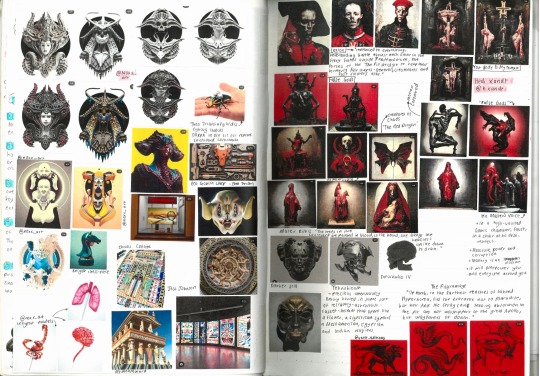Text
Exhibition considerations
Over the last few weeks I have been drafting a plan of my final exhibition in my workbook, I'll note all my considerations and ideas here for further reference:
Thinking about the act of the 'ritual' or 'rite', religious or solemn ceremonies consisting of a prescribed series of actions. Having set instruction for ritualistic activations.
'Portals': as gateways to fantasy places/ ideologies/ enchantment, connotations to videogame markers/ tracks/ objectives- objects/ monuments as 'activators' of a prescribed chain of events.
Want my work/ installation to simultaneously feel like it has connections/ associations to these three things:
Science-Fiction: technological advancements, AI, space (spacecrafts, alternate universes)
Ancient mythology and biblical reverence: Esoteric and prestigious symbolism, hieroglyphic qualities of information. Ritualistic
Video games: algorithmic, predetermined objectives. Object/ monument of activation- portals. Inventories, maps, parameters of a digital world (everything is coded, nothing by chance- you may feel that you have agency in a video game, but every action you take is predetermined and unlocks a specific chain of events.) Digital fantasy worlds
Initially I was intent on splitting the exhibition into two sections, the instructions (realm maps) and then the activation (obelisk). The realm maps acted as the instruction/ context/ establishment of rules, which is then applied to the obelisk, which is the activation of those instructions. A creation, becoming, ritual, game, activation of enchantment. Idea of worship, or contribution to, or partaking in.
However, I don't see this applying anymore. I see the obelisk as an individual work from the realm maps, they all branch out from the same project but I don't see them as connected. And also, if they were connected then I felt it was unbalanced, the obelisk work is significantly more impressive than the maps, and would do them injustice. Therefore, I want to treat each work individually and do my best to activate the potential in each work separately.
The Obelisk is tall (just over 2 metres), and it will be placed on an elevated platform. Sacred monument? Esoteric? Intimidating or inviting? People won’t be able to step onto the platform, how to make this indirectly obvious? Creating unspoken/ indirect ‘rules’ to follow. Where can you stand, what can be touched and approached? RULES OF ENGAGEMENT

Hieronymous Bosch, The Garden of Earthly Delights. Ramping up a very complex and maximal visual information, while retaining a standard of sleekness and professionalism (something that I admire about Simon Denny’s works). Bosch’s work, the quality of a maximal image drawing you in to the small details- very happy to be embracing this

Dante’s Inferno. The Map of Hell painting by Botticelli.
Intersecting all these different ways of visualising information that I like: Diagrams (tiers and icebergs), way to visualise concepts around class systems, hierarchies, etc. And a method of gamification in relation to different levels, maps, manuals, inventories. Arrangement of different components: places, objects, archetypes.
0 notes
Text



13.11.23
Obelisk collected from Panda Visuals, and partially assembled, there is a pinnacle that belongs on top which will be embelished with gold leaf to symbolize the obelisk's connection to the sun and divinity.
Although this was a very expensive purchase I'm extremely happy with it, I adore this obelisk. The decision to get it professionally printed on specialty cardboard saved me a lot of time and stress as the alternative option was to build it myself from MDF, and then to manually apply sheets of images- even if I were to be very careful and deliberate doing so, I can't imagine this ever turning out good. The printing quality is amazing, I actually had to remake the entire file once over because the quality wasn't quite right, and I'm so glad that I made that sacrifice.
Plans from here: Although the printed obelisk is lovely, I feel the need to make further additions to it manually, to fully give it my personal effort and touch. This will be done through the careful addition of gold leaf, and in the future I can envision using actual brass/ metal plating and brackets to cover the edges- like they do in book binding. The images have these 'walls' on the very edge of each side, how to turn a 2D image into a textured, real addition? I can imagine that wall being slightly lifted from the surface as 3 dimensional pieces
0 notes
Text
Assortment of notes and quotes I’ve collected over time:
“I have always kept you closer than you’ve known, I, I am riding in the shadows behind you on a pale white horse. You’d never me to appear, you’d never want this to be other” - Witch Image, Ghost
The Four Last Things: Death, Judgment, Hell, Heaven - Van. Cochem Martin: “The evil spirits will tempt their unhappy victim at the moment of death on various points, but especially in regard to the sins into which he has most frequently fallen.” - pg 16
‘Paracosm’ - a detailed imaginary world created inside one’s mind. This fantasy world may involve humans, animals, and things that exist in reality’ or it may also contain entities that are entirely imaginary, alien, and otherworldly.
‘Orwellian’ - characteristic of the writings of George Orwell, especially with reference to his dystopian account of a future totalitarian state in Nineteen Eighty-Four
“Around the most distant, a group of men was staring at something in the water, an object that one of them was prodding with a boat hook- Attilius had to shield his eyes to make them out- and as he studied them more closely he felt his stomach hollow. It reminded him of the moment of the kill at the amphitheater- the stillness of it, the erotic complicity between crowd and victim.”- Robert Harris, in Pompeii
How to Justify Torture: Inside the Ticking Bomb Scenario, by Alex Adams
Crime and Punishment, Rodion Raskolnikov
0 notes
Text
Forgot to post this earlier, went to the ‘Gothic Returns’ exhibition at the Auckland Art Gallery, and the ‘Medieval Manuscripts’ exhibition at the Auckland Library! Thanks Phoebe for going with me, this was such an awesome experience and I plan to go again soon- specifically to the gothic exhibition, it has etchings from Goya, beautiful!
Gothic Returns: Fuseli to Fomison
“This exhibition explores the persistent appeal of ‘the gothic’, a broad term that embraces some of the most darkly charismatic imagery ever produced. Incorporating all things febrile, esoteric, sombre and downright scary, this nebulous genre has its origins in the late 18th century British Romantic movement. First defined by thee medievalising novels of Horace Walpole (1717-1797) and the disturbingly sensual paintings of Swiss artist Henry Fuseli (1741-1825), it has since proven almost virus-like in its capacity to adapt and thrive across centuries. Whatever outward form it assumes, the gothic has also shown itself remarkably true to its essential character: ominous moods, unsettling themes and a melancholy engagement with the past.”


(Above left) Barry Cleavin, NZ, Menage a trois, etching and photo-engraving
“Inspired by predecessors such as Francisco Goya, Barry Cleavin utilises historical imagery to expose society’s dark, seedy underbelly. Both the lean, muscular figure standing in contrapposto pose and the work’s scenic, Neoclassical background are drawn from an 18th-century anatomical manual. Superimposing onto those images a harpy and a group of drowning figures culled from a 19th-century Romanticist depiction of a passage from Dante’s Inferno (1314), Cleavin implies that the Enlightenment project to understand and visualise the interior of the human body is not a disinterested science but a sick and twisted fantasy.”
(Above right) Henry Fuseli, The Serpent Tempting Eve (Satan’s First Address to Eve), 1802, oil on panel
“With its themes of confused morality and seductive evil, Paradise Lost (1667) by the revolutionary poet John Milton (1608-1674) had a profound influence on gothic art and fiction. Henry Fuseli painted numerous subjects from Milton’s poem, including this scene, in which a handsome Satan with the body of a serpent beguiles Eve into eating the forbidden fruit from the Tree of Knowledge of Good and Evil. Eve then persuades Adam to do the same, leading to their expulsion from Paradise. The biblical story of Eve’s gullibility was often used as proof of women’s weaker minds and moral character and to explain their susceptibility to the dark arts of witchcraft.”

(Above) Ronnie van Hout, Psycho, 1999, house model
“The Victorian mansion, with its too-many rooms, has been imagined time and again as a living tomb for outcasts as it has declined into a forlorn relic of urban and social change. Identified by filmmaker Alfred Hitchcock as a structure that can literally breed insanity, few who have seen his 1960 horror film Psycho can enter such places without a feeling of stifled dread. In an overt nod to the cinematic classic, Christchurch-born Ronnie van Hout’s miniature sculpture of a Gothic villa reclaims the idea of the lonely Victorian mansion as a metaphor for the tormented artist’s mind. Through an upstairs window, the artist can be seen going knife-wielding mad in a tiny film, trapped in a mental and auditory landscape of B-grade horror movie tropes.”


(Above left) Edmund Sullivan, Persephone, 1906, lithograph
“A century after the birth of ‘the gothic’, an interest in its lurid themes and irrational energy resurfaced in the Symbolist movement and its related decorative style, known as Art Nouveau. The mythological story of Persephone was widely known through Ovid’s Metamorphosis. In it, Persephone, daughter of the goddess of the harvest, is abducted by her uncle Hades while smelling narcissi in the fields of Enna. Enjoyed for its thrillingly transgressive themes of illicit love and the Underworld, in this image British illustrator E J Sullivan exploits the erotic tension of two bodies merging into one continuous outline as Persephone embraces her lustful captor in a dreamlike ecstasy.”
(Above right) Henry Armstead, Satan Dismayed, circa 1852, bronze
“Henry Armstead’s sculptures captivated proponents of the Gothic Revival in mid-19th-century England. A depiction of a celebrated passage from John Milton’s Paradise Lost (1667), this bronze shows a lithe, sensuously rendered Satan recoiling as the Son of God transforms the Devil’s benighted followers into slithering, serpentine demons. Milton’s Satan was the prototype of many hero-villains in Victorian Gothic novels. Proud, vain and driven by a perverted desire to corrupt and destroy others, he is here insidiously portrayed as a figure of alluring, angelic beauty.”
2 notes
·
View notes
Text

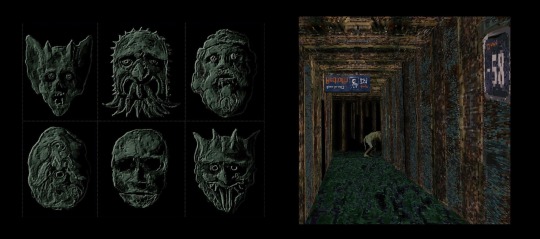


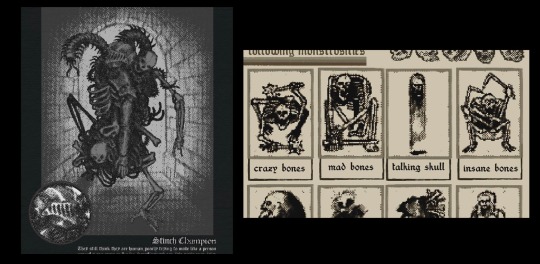
Thank you Phoebe for showing me this artist known as ‘plastiboo’ on Instagram!
Their work pertains to videogame aesthetics and monster design so of course I am immediately interested in them. I'm not entirely sure why, and it may be their artistic style, but the images feel AI generated- which is a compliment. Uncanny valley, disturbing/ unsettling, esoteric, glitchy/ grainy/ gritty textures- the sensation of touching shiver-worthy textures (like sand or chalk). Both disturbing and very interesting, and I aspire to be able to create work in the same vein that holds the weight of a complex world/ language/ symbolism behind it. It is just artwork, but it feels like it is screenshots of an actual videogame- how to make my work feel like this?
1 note
·
View note
Text
Meeting with Glen!
02.11.23
Existential theory- find a specific theorist. Possibly Nietzsche, both an existentialist and nihilist. Idea that men must accept that they are part of a material world, regardless of what else might exist. As part of this world, men must live as if there is nothing else beyond life. A failure to live, to take risks, is a failure to realise human potential. Belief that morality can not be reasonably dictated by religion, atheistic nihilism- With the death of God and the loss of moral absolutes, we are exposed to existence “in its most terrible form… without meaning or aim”
Aleatory game structure- chance, unpredictability, an aspect of existentialism
Comparing existentialism to the structure and process of board games, identical in many ways. However, my boardgames have always been seemingly skewed and unequal towards the Aggressor, an indication of my personal lean towards pessimism- belief that evil will ultimately prevail over good.
Concept of ‘morality’ since the inception of Christianity, morality being associated with the ‘divine’
Changes with different cultures, in Greek mythology morality is perceived as a distinctly ‘human’ issue, because the gods were not very moral- Zeus.
Crucial to ‘morality’ is EMPATHY and OUTRAGE. Two things that trigger the desire for morality
I am specifically interested in the Internet’s impact on our collective idea of morality. Algorithms seek attention and intentionally trigger outrage- ethics of outrage and moral issues- something to research further
Note on my exhibition presentation, has this quality of being within a virtual world, which is great because all of my research and ideas do tie back to the Internet
‘Utopia’ coined by Thomas More- cynical story because he writes it knowing that it can not be achieved (no-place)
Make sure to define ‘Satan’ and ‘God’, what they represent, what their background is
Acknowledge that it is following primarily Christian ethics
‘Character’, characterisation- method of gamification. In relation to archetype
Whose ideologies are we talking about?
What’s important with these particular ethics?
LUCIFER- Greek for ‘light-bearer’ - morning star. Heralding the sun, meaning Lucifer has a head-start over God (the day)
^ Pertaining to the universal ideas and stories around ‘the adolescent son rebelling against his father (God)’ - Obeying and disobeying
Be very clear about biblical characters and their characteristics, what they symbolize
Archetypes of humanity
Sigmund Freud’s Id/ Ego/ Superego deviated within ‘Transactional Analysis’ by Eric Berne. Psychoanalytic theory wherein social interactions (or “transactions”) are analyzed to determine the ego state of the communicator (whether child-like, adult-like, or parent-like) as a basis for understanding behaviour. Very interesting!
Make clear the difference you stray from the usual meaning of the original term- just be clear whether it is sourced information or your own personal interpretation
Always define what you are talking about, establishing the histories these terms originated from and the importance of that
0 notes
Text
Meeting with Matt (:
01.11.23
Didn’t write many notes, but had a very good conversation
Choice of engagement and participation- how do I want the viewer to interact with the work? Worship? Admiration? Fear/ intimidation?
Focus is on the experience of encountering this work.
The Obelisk is tall (just over 2 metres), and it will be placed on an elevated platform. Sacred monument? Esoteric? Intimidating or inviting?
People won’t be able to step onto the platform, how to make this indirectly obvious? Creating unspoken/ indirect ‘rules’ to follow. Where can you stand, what can be touched and approached?
Hieronymous Bosch, The Garden of Earthly Delights, yay! Ramping up a very complex and maximal visual information, while retaining a standard of sleekness and professionalism (something that I admire about Simon Denny’s works). Bosch’s work, the quality of a maximal image drawing you in to the small details- very happy to be embracing this

Dante’s Inferno. The Map of Hell painting by Botticelli.
Intersecting all these different ways of visualising information that I like: Diagrams (tiers and icebergs), way to visualise concepts around class systems, hierarchies, etc. And a method of gamification in relation to different levels, maps, manuals, inventories. Arrangement of different components: places, objects, archetypes.


A 'Hellmouth' is a symbolic monster found in many Christian works relating to Hell or similar purgatories, envisioned as a gigantic monster with a gaping mouth it acts as the entrance to the spiritual plane of suffering and death; which in many ways it embodies.
0 notes
Text
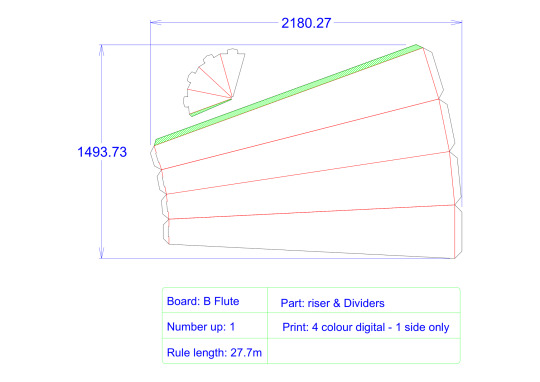

Obelisk design, this is being professionally printed and created by Panda Visuals.
A structure/ monument characterised by a four-sided square base that tapers into an isosceles pyramidion tip.
Symbolism of the Obelisk:
Origins in Ancient Egypt, a symbol of faith towards and the power of the sun god Ra (God of the sun, order, and creation), have kingly (divine masculine) connotations, representing the connection between the spirit of the king and the sun god
Long tapering form functioned to connect the heavens to the earth, guiding the souls of the dead to the afterlife, often placed at the entrance of tombs
Connection to the sun: pinnacles were typically covered in gold to reflect the sunlight, attracting the reviving rays of the sun
Solar relationship: often arranged according to traditional patterns that honour the rising and setting of the sun
Funerary monument symbolising rebirth, resurrection, eternity and immortality
Reminder of faith’s potency and ability to provide strength and guidance in times of difficulty
Corrugated cardboard display, flat packed and assembled as fold out pieces. Connotations with commercial marketing displays. Professional but also intentionally tacky/ consumerist/ commercial
0 notes
Text

9 Circles of Hell (Dante’s Inferno)
Inferno, the first part of Dante’s Divine Comedy, written in the 14th century, describes the poet’s vision of Hell. Inferno is followed by Purgatorio and Paradiso. This features Dante’s journey through the Nine Circles of Hell, guided by the poet Virgil. At the beginning of the story, a woman named Beatrices, calls for an angel to bring Virgil to guide Dante in his journey so no harm will befall him.
‘Contrapasso’ (!): meaning “suffer the opposite”, is the punishment of souls “by a process either resembling or contrasting with the sin itself.”
‘Purgatory’ (in Catholic doctrine): meaning a place or state of suffering inhabited by the souls of sinners who are expiating their sins before going to heaven. A cleansing.
1 Limbo:
The unbaptised and virtuous pagans, those who never knew Christ existed. Dante encounters Ovid, Homer, Socrates, Plato, Aristotle, Julius Caesar, and more here.
2 Lust:
Souls are punished by being blown about in violent winds, preventing them from finding any rest or peace. Dante encounters Achilles, Paris, Tristan, Cleopatra, and Dido, among others here.
3 Gluttony:
Overlooked by a worm-monster Cerberus, sinners in this circle of Hell are punished by being forced to lie in never-ending icy rain and slush. The slush symbolises the personal degradation of one who overindulges in food, drink, and otherworldly pleasures, as well as the inability to see others through the rain (representing selfishness and coldness). Dante encounters ordinary people here, not characters from epic poems or gods from mythology.
4 Greed:
Punishment is divided into two groups of sinners- those who hoarded possessions, and those who lavishly spent it. The two groups are forced into a joust, using great weights as weapons which they have to push against each other using their chests (symbolising selfish drive for fortune). The groups are guided by a character called Pluto (likely representing the mythological Greek rule of the Underworld). A lot of clergymen, cardinals, and popes are present here as well as more ordinary people. This is the first time they pass through a circle without speaking to anyone, a commentary on Dante’s opinion of greed as a higher sin.
5 Wrath and Sullen:
The wrathful are forced to fight one another on the surface of the river Styx, while the sullen lay gurgling beneath the surface of the water. Dante and Virgil are threatened by the Furies when they try to enter through the gates of Dis. This is a further progression into Dante’s evaluation of the nature of sin, he begins to question himself and his own life, realising his actions and nature could lead him to this permanent torture.
6 Heresy:
Rejection of religious and/ or political norms. Heretics are trapped in flaming tombs for eternity.
7 Violence:
This Circle is segmented into a further three rings. The Outer Ring houses murderers and others who were violent to other people and property, here Dante sees Alexander the Great, the Centaurus (sank into a river of boiling blood and fire), and Attila the Hun. Centaurs guard this Outer Ring and shoot its inhabitants with arrows.
The Middle Ring comprises of those who are suicidal, they are turned into trees and bushes which are fed upon by harpies.
The Inner Ring contains the blasphemers, sodomites, usurers, those who are violent against God or nature. They reside in a desert of burning sand and burning rain falling from the sky. One of the sinners is Brunetto Latini, a sodomite, who was Dante’s own mentor, Dante speaks kindly to him.
8 Fraud:
Dante and Virgil reach the Eighth Circle on the back of Geryon, a flying monster with different natures, just like the fraudulent. Within this Circle is the ‘Malebolge’ (meaning ‘Evil Pockets’), which is divided into 10 Blogias (meaning stony ditches) with bridges between them. Each Bolgia is guarded by different demons, and the inhabitants suffer different punishments, such as the simoniacs, who stand head first in stone bowls and endure flames upon their feet.
Bolgia 1: Panderers and seducers.
Bolgia 2: Flatterers.
Bolgia 3: Simoniacs (those who sell ecclesiastical preferment).
Bolgia 4: Sorcerers, astrologers, and false prophets.
Bolgia 5: Corrupt politicians (Barrators).
Bolgia 6: Hypocrites.
Bolgia 7: Thieves.
Bolgia 8: Evil and false counselors and advisers.
Bolgia 9: Divisive individuals, Schismatics (those who seperate religions to form new ones).
Bolgia 10: Various falsifiers such as alchemists, perjurers, counterfeiters, impersonators etc.
9 Treachery:
The final Ninth Circle of Hell is divided into 4 rounds, according to the seriousness of the sin. Satan resides here. All residents are frozen in an icy lake, the depth of one’s immersion within the ice depends on the severity of their sin. Each of the 4 rounds are named after an individual who personifies the sin, and each subdivision have their own unique demons and punishments.
Round 1, Caina: Named after the biblical figure Cain, who murdered his brother Abel. This round is for traitors to family.
Round 2, Antenora: Named after Anthenor of Troy, Priam’s counselor during the Trojan War, whom betrayed the Greeks. This round is reserved for political/ national traitors.
Round 3, Ptolomaea: Named after Ptolemy, son of Abubus, who is known for inviting Simon Maccabaeus and his sons to dinner and then murdering them. This round is for hosts who betray their guests, they are punished more harshly because of the belief that having guests means entering into a voluntary relationship, and betrayed a relationship willingly entered into is more despicable than betraying a relationship born into.
Round 4, Judecca: Named after Judas Iscariot, the apostle who betrayed Christ. This round is reserved for traitors to their lords/ benefactors/ masters.
0 notes
Text
Meeting with Glen
19.10.23
Art or fan of this topic?
Using imagery as gateway into ideas
Thomas More’s Utopia, cynical political text - look for 500 year anniversary edition with Ursula Le Guin’s text
Utopia as a greek pun. ‘Eu-topia’ meaning ‘good place’ and ‘u-topia’ meaning ‘no place’.
Rich territory for reflection on the state of ‘play’
Game skewed towards darker themes, commentary on world? - Could do with balancing out?
Negotiation and balance between being hopeful and being realistic
Game reflecting the world- need to be in control of what it is reflecting- ethics and politics
Idea of ‘entrenchment’
Post-covid: small factions/ groups disenfranchised from society
Late condition of capitalism
Focus on finding specific books. Democracy vs Capitalism. Demise of Capitalism.
Utopia - Foundation of Democracy- Roman Senate (aristocratic)
Deleuze and Guattari’s Anti-Oedipus: analyzing the relationship of desire to reality, and to capitalist society in particular. Critique of Freudian Oedipus-Complex
Simon Denny
Archetypes: mother figure? Characters buying into old world patriarchy
Aleatory (chance), but biased towards and in favour of the Aggressor
No one would ever encompass the ‘Aggressor’ (Satan), because no one would believe they are an ‘Aggressor’. One believes in their own truth and morality, we all have personal truths and beliefs on right and wrong. The problem of entrenched positions, you are not able to see how entrenched you are. Empathy: the ability to understand another’s position.
Don’t close the research around ‘gaming’, allow it to open up
1 note
·
View note
Text
Meeting with Yolunda regarding end of year work
18.10.23
What does 'active' look like to you?
What are the ways that could create that feeling?
Moment of 'encounter' leads to the feeling of wonder and enchantment
Idea of readiness, and the work being already poised, something that has already been activated
Creating the feeling, not the mechanics
0 notes
Text
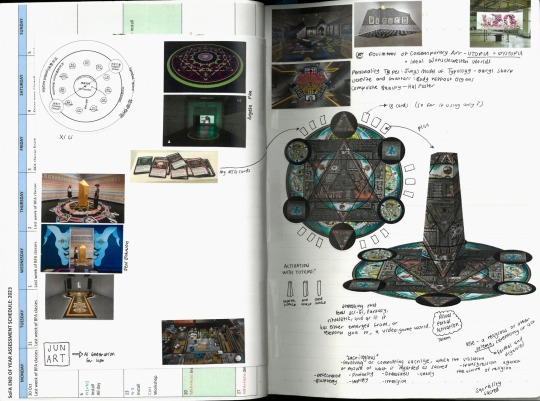
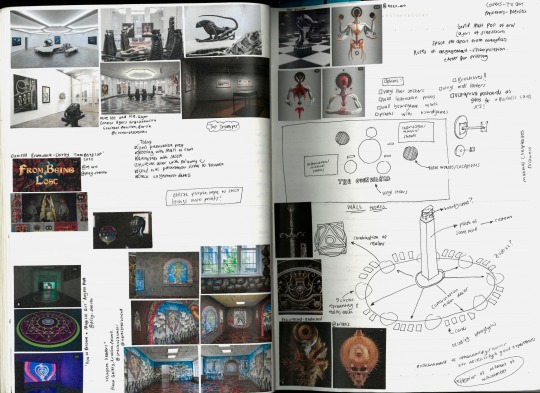
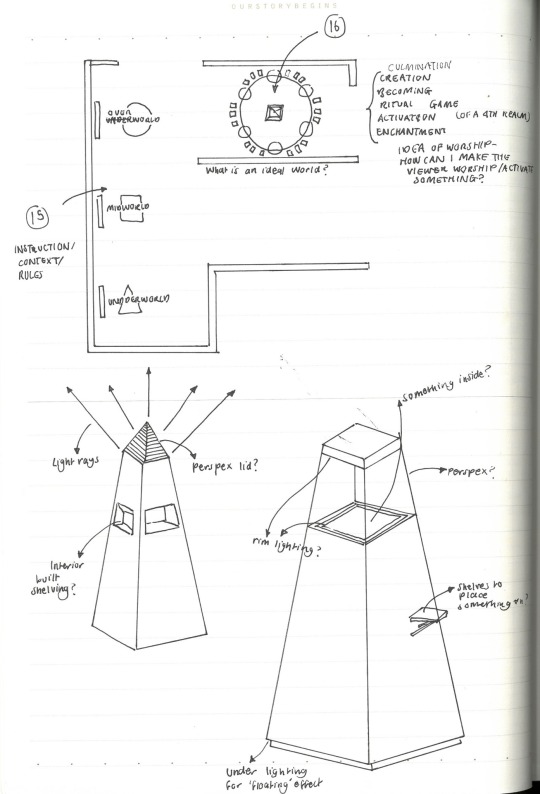

Workbook pages in preparation for end of year
Top Image:
To the left are my initial artist models, including work from Jess Johnson, Xi Li, and Angela Pan.
Esoteric diagram, connection to occultism
Symbolism of the sigil: meaning "seal." In medieval magic, the term sigil was commonly used to refer to occult signs which represented various angels and demons which the practitioner might summon. The magical training books called grimoires often listed pages of such sigils.
Portal-esque (like from a video game)
0 notes
Text

Obelisk structure plan, with vinyl floor sticker
Thinking about the act of the 'ritual' or 'rite', religious or solemn ceremonies consisting of a prescribed series of actions.
Then thinking about the 'portal', gateways to fantasy or spirituality, connotations to videogame markings/ trackings/ objectives
And then this idea of 'activation' through ritual, activating enchantment, activating fantasy within reality.
I want to create something that belongs within science-fiction and fantasy, while also feeling ritualistic, and if it either emerged from, or teleports you to, a digital fantasy world (referencing videogames).
Splitting the exhibition into two sections, the instructions and then the act of action. Instruction/ context/ establishment of rules, then this obelisk sculpture as a creation, becoming, ritual, game, activation of enchantment. Idea of worship, or contribution to, or partaking in. How can I make the viewer participate in this ritual?
0 notes
Text

A diagram of the places I am creating. The Dystopia, fake Utopia, and the Enchanted World all stem from Reality.
I have already created realms for Reality (Midworld), Dystopia (Underworld) and fake Utopia (Overworld), but there is a fourth possible realm that represents the Enchanted World (not visualised into a realm yet).
All of these realms exist within this concept of Existentialism, relating to philosophical questions of the meaning, purpose, and value of human existence. As part of understanding this belief we develop our own set of morals, and from this we are able to define what we believe are ‘bad worlds’ (Dystopia) and ‘good worlds’ (Utopia). I’m interested in understanding how factors of religion, politics, culture, and personality types influence our personal definitions of this, resulting in there being no collective agreement on what constitutes Utopias and Dystopias.
In this diagram I am specifically interested in the ‘fake Utopia’ and the ‘Enchanted World’, because they aren’t as clearly defined as the other realms. Reality is defined as our physical reality, and as I mentioned in a previous post, the Dystopian world is easier to define because we know what we hate/ are scared of, but we become indecisive when trying to understand what we want and desire (why a Utopia is harder to define).
The ‘Fake Utopia’ is created as 1) an attempt to escape the idea of Dystopia, and 2) as an attempt to access the real Utopia, the ‘Enchanted World.’
The ‘Fake Utopia’ is easier to create because it is heavily constructed, but the ‘Enchanted World’ can not be visualised easily, it is more up to personal interpretation, and it is temporary so it can not physically exist. It is rather a metaphysical experience which can be activated through portals (things and experiences that transcend you beyond reality and towards fantasy).
1 note
·
View note
Text
Field of enquiry
3 core questions/ statements/ concepts that I am addressing currently (and in the entirety of my practice so far)
Existentialism- Philosophical questions related to the meaning, purpose, and value of human existence, the belief that we are responsible for creating purpose or meaning in our own lives- through what means? Entails the processes of trying to gain agency over oneself
Gamification as a manifestation of 'fantasy' (including escapism and 'enchantment') within reality. Looking at both abstract modes of gamification (to understand structures within reality), and extremely specific modes (the trope of 'gaming' and 'games')
The debate of what defines a dystopia and a utopia. What is the ideal world? Is it one that exists within the realm of fantasy, is it attainable in reality?
0 notes


